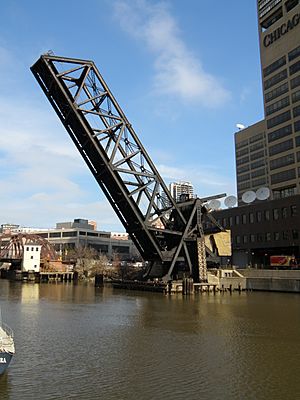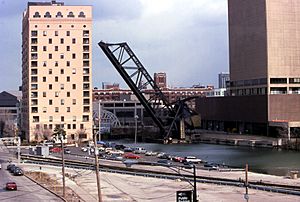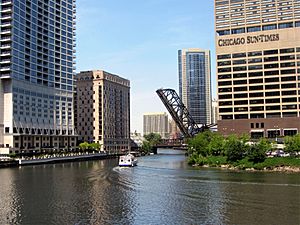Kinzie Street railroad bridge facts for kids
Quick facts for kids Kinzie Street railroad bridge |
|
|---|---|

Kinzie Street railroad bridge permanently locked in the raised position
|
|
| Crosses | Chicago River |
| Locale | Chicago |
| Official name | Chicago & North Western Railway, Kinzie Street drawbridge |
| Other name(s) | Carroll Avenue bridge |
| Heritage status | Chicago Landmark |
| Characteristics | |
| Design | bascule bridge |
| Total length | 195.83 feet (59.69 m) |
| Width | 41.7 feet (12.7 m) |
| Longest span | 170 feet (52 m) |
| History | |
| Construction begin | December 1907 |
| Opened | September 19, 1908 |
The Kinzie Street railroad bridge is a special kind of bridge called a bascule bridge. It crosses the north branch of the Chicago River right in downtown Chicago, Illinois. It's also known as the Carroll Avenue bridge.
When it first opened in 1908, this bridge was amazing! It was the longest and heaviest bascule bridge in the whole world. Before this bridge, other bridges stood in the same spot. One was the very first bridge to ever cross the Chicago River. Another was Chicago's first railroad bridge. Plus, one of the first all-steel bridges in the United States was here too.
The bridge hasn't been used for trains since the year 2000. That's when the Chicago Sun-Times newspaper, its last train customer, moved out of downtown Chicago. Even though it's not used daily, it's still important. In 2007, it was named a Chicago Landmark. This means it's a special part of Chicago's history.
Crews still check on the bridge every year. They lower it once a year and inspect it carefully. This keeps the bridge in good shape, even if no trains cross it anymore.
History of the Kinzie Street Bridge
For many years, boats on the Chicago River and trains on the tracks were always competing for space. In the past, bridges would swing open to let boats pass. But this often caused problems for trains.
One time in 1879, a train with 800 people almost crashed! It was going too fast towards an open swing bridge. Luckily, it stopped just in time, with its front wheels hanging over the river.
As boats on the river got bigger, it became harder for them to get past the old bridges. The Army Corps of Engineers, who manage waterways, decided something had to change. They ordered three old swing bridges near Kinzie Street to be removed. These bridges were blocking river traffic too much.
So, in 1907, work began on a brand new bridge. This new bridge was a bascule bridge, which lifts up to let boats pass. This design gave boats much more room. The new bridge was also built to carry two railroad tracks across the river. It was a big improvement for both trains and boats!
Future Ideas for the Bridge
Even though the Kinzie Street railroad bridge isn't used by trains anymore, people have ideas for its future. Back in the 1970s, some people thought about using the old train tracks for a new light rail line. This line could connect downtown Chicago train stations with the River North area.
More recently, in 2008, the City of Chicago Department of Transportation looked into a new plan. They thought about creating a transit link using an old train tunnel. This tunnel runs under buildings like the Apparel Center and the Merchandise Mart.
The idea was called the Carroll Avenue Transitway. It would involve changing the Kinzie Street railroad bridge. The bridge could be updated to carry buses or even trams instead of trains. This would help people travel around Chicago in new ways.
Images for kids
-
Night view looking north from Lake Street bridge showing Wolf Point and Kinzie Street railroad bridge.
-
Bird's-eye view of Wolf Point in 1893. The 1879–1898 swing bridge is visible.








